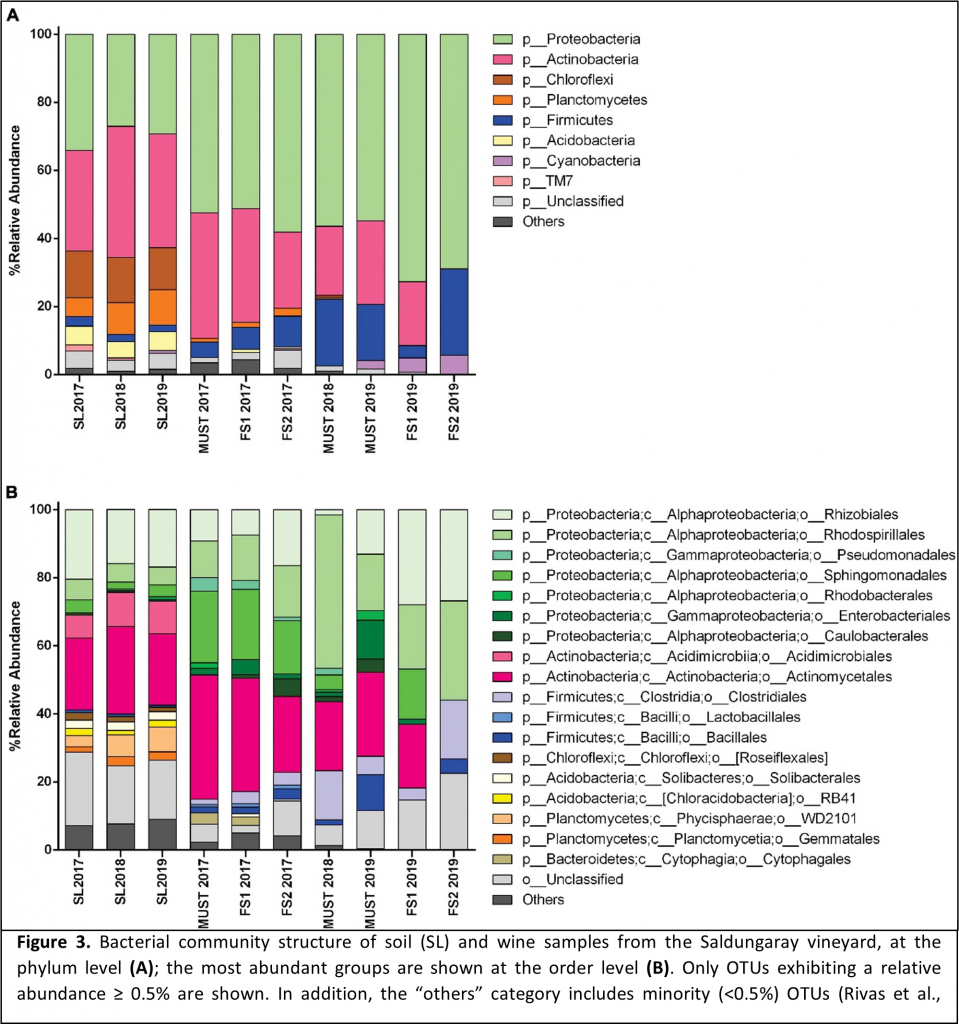By Gabriel Alejandro Rivas
Argentina is ranked as the fifth wine world producer after Italy, France, Spain, and the United States. Although most of the traditional wine-producing regions are located along the Andes Mountains range, new vineyards have been recently established in the southwest of Buenos Aires Province, and it is a thriving activity of great cultural and economic value. In this work we studied the variations in soil and wine bacterial diversity of the Malbec variety through three consecutive vintages (2017, 2018, and 2019), and how climatic conditions affected said diversity.
The temperatures varied significantly between the vegetative periods analyzed (Figure 1). At the beginning of the 2016–2017 vegetative period the maximum temperatures were lower than in the following years, with a hotter summer (p < 0.05). On the other hand, at the beginning of 2018 the minimum temperatures were slightly but significantly higher compared to the other periods, while for November 2017 (spring), a markedly lower temperature was recorded (p < 0.05), including an unseasonable frost. According to reports by the Saldungaray winery, this event had a vastly negative impact on the fruits that were in the process of growth/ripening, resulting in a loss of grape production, which prevented the individual elaboration of the different varietals.

Regarding ground water availability, from the hydrological balances built for the decade, we observed a pattern in which there is a recovery time, usually during the beginning of the vegetative period (April), even to the point of hydric excess, followed by a more or less extended period of ground water depletion, then water deficit (drought) until harvest time. For the years studied, the longest drought period was 2016–2017, which began with the depletion of reserves in mid-July (winter) 2016, followed by a long period of water deficit from early November (mid-spring) until March 2017 (late summer). Conversely, at the beginning of the vegetative year 2017–2018, a great ground water surplus was registered followed an atypically abundant rainfall in April, which sustained the ground water reserve until mid-September (early spring). These frequent water shortages led to lower yields, especially in the period 2015–2017. The year of lowest production was 2018, as a consequence of the unseasonable frost already mentioned. Within the decade, 2016 was the worst year for the whole country in terms of production due to severe drought; a partial recovery was observed in 2017 followed by a more pronounced recovery in 2018 (OIV, 2020).
To study the soil and wine microbial diversity, taxonomic analysis were performed (Figure 2). The Actinobacteria and Proteobacteria accounted for almost 60% of the total soil bacterial communities. The 2017 vintage, corresponding to the driest vegetative year, shows a slightly higher relative abundance of Proteobacteria, followed by a shift in the dominance of Actinobacteria, mostly Actinomycetales y Acidimicrobiales, in 2018 and 2019. This was not surprising given that most members of Actinomycetales have slow growth rates, low nutritional requirements, and high affinity for complex molecules, and that some of them have stress-resistance structures like thick cell walls or endospore formation capacity. These combined features allow them to persist under drought or further stress conditions, such as the low availability of organic carbon in the vineyard soil under study. Several works have recorded significant enrichment in Actinobacteria in soil, rhizosphere and root-endophytes during droughts for different plants, and across a range of environments.
The Actinobacteria and Proteobacteria were the most abundant groups in wine samples as well (accounting for almost 70-80%). Firmicutes was also registered, which is a relevant phylum in wine samples because it includes the order Lactobacillales (a technologically important group in wine). However, it is apparent that the Lactobacillales were absent from almost every sample, except for wine samples of the 2017 vintage, in which they were recorded at a low relative abundance (1% or less). Nonetheless, we were able to obtain isolates of LAB after successive enrichment cultures from the 2019 samples. We believe that LAB might have been in extremely low concentrations in the 2019 samples and the lack of detection might be due to a limitation in the sequencing technique employed. Furthermore, a high relative abundance was observed for the Acetobacteraceae family in all wine samples, including the genera Swaminathania, Acetobacter, and Roseomonas, acetic acid bacteria (AAB) which are potentially detrimental as they may cause spoilage in wine. To evaluate the presence of specific bacterial taxonomic groups and the evolution of microorganisms throughout the years studied, the taxa identified were compared at the order level. Fourteen orders for the soil samples and nine for the wine samples were identified. For the soil, the number of specific taxonomic groups was variable, although it increased toward 2019: 2 were recorded for the year 2017, 1 for the soil 2018, and 4 for the soil 2019. Conversely, a decrease in diversity was evidenced for wine samples, where detected 6 unique orders in 2017 wine, 1 in 2018 and none in 2019. Furthermore, through this analysis, we were able to determine that the soil would not be acting as a biological reservoir for LAB but for AAB.

We believe that our work provides valuable information for vintners in areas of comparable climatic conditions. We showed that the soil microbiota is largely adapted to these challenging conditions and can withstand even prolonged droughts. The microbial structure of the bacterial community of the wine seems to be affected by climatic factors as well. This is relevant from the point of view of definition of terroir in the productive area, monitoring of microbiota under stressful conditions, and microbial ecology in general.

Gabriel Alejandro Rivas. Ph.D. in Science and Technology
See curriculum vitae here.
References
Rivas GA, Guillade AC, Semorile LC and Delfederico L (2021) Influence of Climate on Soil and Wine Bacterial Diversity on a Vineyard in a Non-traditional Wine Region in Argentina. Front. Microbiol. 12:726384. doi: 10.3389/fmicb.2021.726384.

